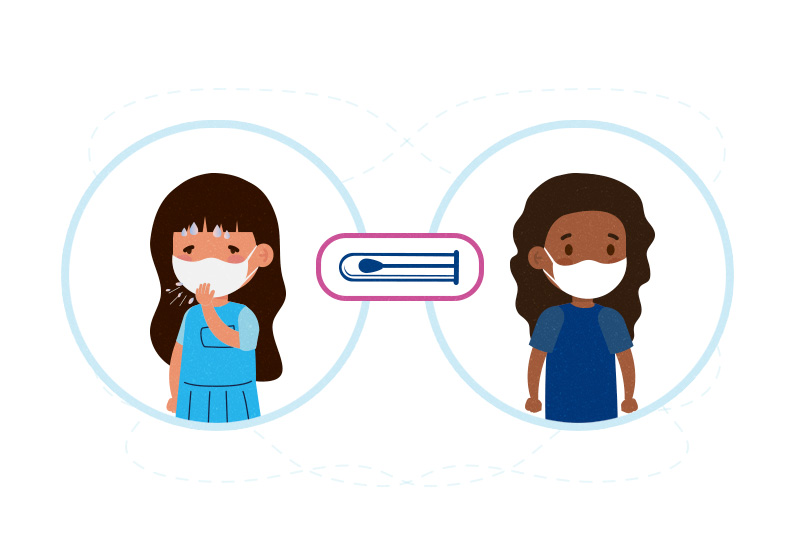COVID-19 virus levels in children: Differences between asymptomatic vs. symptomatic kids

A new study finds that most asymptomatic children who tested positive for COVID-19 had lower levels of the virus compared to symptomatic children. While it is the first large and comprehensive investigation of its kind in asymptomatic children, several important questions remain unanswered.

“Our study did show that asymptomatic children had lower viral loads at the time of testing,” says senior author and principal investigator Nira Pollock, MD, PhD, associate medical director of the Infectious Diseases Diagnostic Laboratory at Boston Children’s Hospital. “But the question is why — and what are the implications?”
Diabetes, recent COVID-19 contact associated with higher virus counts
Key takeaways:
- In COVID-19, virus load appeared to be lower in asymptomatic children than in symptomatic children.
- Asymptomatic children with a history of diabetes, recent exposure to a COVID-19 case, or testing for surveillance purposes had the highest viral load; but most were still significantly lower than in symptomatic children
- The difference may have had more to do with timing of testing in asymptomatic children
- The findings raise caution about using low sensitivity tests for asymptomatic screening programs in pediatric populations.
The study, published in the Journal of Clinical Microbiology, included 339 asymptomatic and 478 symptomatic children ages 0-17. Children in the study screened positive for COVID-19 using PCR tests at nine children’s hospitals across the United States and Canada.
The analysis found that asymptomatic children had a significantly higher risk of having a high viral burden (meaning a higher amount of the virus in their nose) if they also had diabetes, recent contact with a COVID-19 case, or were tested for surveillance purposes (meaning they were tested for a known exposure to COVID-19 or as part of testing in the community). The study’s authors believe that children with higher viral loads who were tested for surveillance purposes or for recent contact with a person with COVID-19 were more likely to have had recent infections. It’s important to note, however, that most asymptomatic children had viral loads significantly lower than those in symptomatic children (though some did have a very high virus burden).
Several factors, including compromised immunity, sex, race, and ethnicity, did not appear to be associated with viral load differences in asymptomatic children.
What explains the differences?
The team suggests two main possible explanations for these differences in viral load between asymptomatic and symptomatic children. The first could be just a matter of timing — that the asymptomatic children were tested later in their disease when virus counts are lower. The other possibility is that asymptomatic children don’t ever achieve viral loads as high as symptomatic kids do.
“We now need to know what the peak viral loads are in asymptomatic kids with COVID-19,” says Pollock.
Findings lead to more questions
Are virus counts potentially higher closer to the beginning of infections in asymptomatic children? If tested early in the disease, would they have viral loads as high as symptomatic children? Or do asymptomatic children typically not carry as much virus as children with symptoms? If so, how would lower viral loads impact the risk of transmission? Answering these questions is essential to further clarify the public health impact of pediatric COVID-19.
“While these findings provide some reassurance about the safety of asymptomatically infected children attending school, these unanswered questions suggest that risk mitigation measures in daycares, schools, and the community remain critical to reducing the spread of COVID-19. Children must continue to wear masks, maintain social distance, and wash their hands frequently,” says first author Larry Kociolek, MD, pediatric infectious diseases expert at Ann & Robert H. Lurie Children’s Hospital of Chicago. “At this stage, we can’t predict which children are likely to carry more or less virus, because, in every age group we tested, there were some asymptomatic kids with a higher viral load. However, even the groups of asymptomatic kids with the highest viral load in our study still had lower viral loads than the children with symptoms.”
Rapid tests vs. PCR
The authors also point out that the levels of the virus they found in the asymptomatic children were mostly lower than the levels that the available rapid antigen tests are able to detect.
“It is important to recognize that rapid antigen tests are less sensitive than the PCR tests used in hospitals, and that many of the asymptomatic kids in our study likely would have tested negative using the rapid tests based on our understanding of the limits of detection of those tests,” says Pollock. “Our findings should raise caution about using low sensitivity tests for asymptomatic screening programs in pediatric populations.”
The team hopes this study encourages other studies to better understand the viral loads in asymptomatic children — particularly peak viral loads early in infection.
Read more about Boston Children’s response to COVID-19.
Related Posts :
-

Promising advances in fetal therapy for vein of Galen malformation
In 2024, Megan Ingram* of California and her husband were preparing for the birth of their third child when a 34-week ...
-

The hidden burden of solitude: How social withdrawal influences the adolescent brain
Adolescence is a period of social reorientation: a shift from a world centered on parents and family to one shaped ...
-

A toast to BRD4: How acidity changes the immune response
It started with wine. Or more precisely, a conversation about it. "My colleagues and I were talking about how some ...
-

A unique marker for pericytes could help forge a new path for pulmonary hypertension care
Pulmonary arterial hypertension (PAH) is a rare condition that’s difficult to treat. The hallmarks of the disease — narrowing of ...





